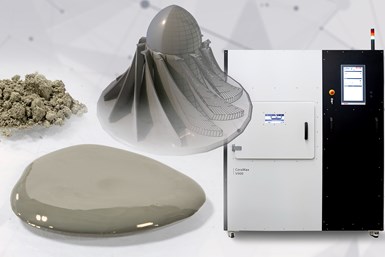Lithoz, ORNL Partner to Advance Processing for High-Temperature Ceramics
The new process could enable laser slurry drying of non-oxide ceramics with high refractive indexes
The technical collaboration will focus on innovating high-temperature ceramics processing via the use of Lithoz 3D printing technology. Source: Lithoz
Lithoz and the U.S. Department of Energy’s (DOE) Oak Ridge National Laboratory (ORNL) have signed a Cooperative Research and Development Agreement (CRADA) to use Lithoz’s 3D printing technology to further explore the processing and additive manufacturing (AM) of non-oxide ceramics.
Based on laser-induced slipcasting (LIS) technology, the Lithoz 3D printer uses laser slurry drying (net shaping) technology to guide computer-controlled light amplification by stimulated emission of radiation that desiccates liquid-suspended controlled layers of solids. The goal of the cooperative agreement is the development of the technology to shape non-oxide ceramics with high-refractive indexes, such as silicon carbide, for use in extreme temperature applications. The new process could enable laser slurry drying of non-oxide ceramics with high refractive indexes
Lithoz launched its LIS technology to produce parts that are far more complex in geometry and larger in scale than can be achieved using conventional molding techniques. By incorporating intricate inner channels and 3D-printable complex designs, the parts it can produce are lighter and more efficient when compared with current methods. This technology is also capable of increasing the range of materials that can be printed by processing dark ceramics, such as silicon carbide and silicon nitride, in a way that is unachievable with other processes.
The goal of this project is to scale up the production of ultrahigh-temperature ceramic parts to an industrial level. The team will look to develop this technology by assessing its technical capabilities using a common oxide-ceramic material. This will involve printing and debinding the primary
material —– such as silicon nitride and silicon carbide, two highly in-demand substances for aerospace applications – from the moulded component. Using heat, the substance will be formed into a solid material in a process known as sintering. The performance and properties of the printed materials will then be tested.
“This project will build on ORNL’s years of research in developing and testing high-temperature materials and ceramics,” said Corson Cramer, Extreme Environment Materials Processing Group
staff scientist at ORNL. “By combining our expertise with Lithoz 3D printing capabilities, we have the potential to change the concept of high-temperature ceramics processing for heat exchange, aerospace and defense applications.”
Related Content
-
Foundry Lab: How Casting in a Day Will Improve the Design of Metal Parts (Includes Video)
The company’s digital casting process uses 3D printing, but the result is a cast part. By providing a casting faster than a foundry, the company says effective prototyping is now possible for cast parts, as well as bridge production.
-
Cranial Implant 3D Printed From Hydroxyapatite Ceramic: The Cool Parts Show #76
Cranial implants are typically made from titanium or PEEK; in this episode of The Cool Parts Show, we look at how implants made from a bioceramic can improve osseointegration and healing.
-
Lithoz CeraFab System S320 LCM Printer Designed for Efficient, High-Capacity Industrial Serial Production
Formnext 2024: The system offers a build speed of up to 150 layers per hour and layer thickness of 20–200 µm.















